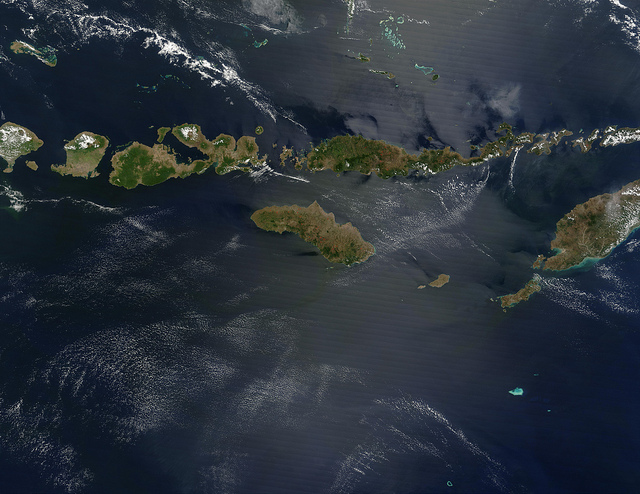
One of the distinctive features of contemporary Indonesia is that it is an archipelagic state in which the government exercises sovereignty over the waters between the islands making up the country’s land territory as well as over the islands themselves.
But the nation we now call Indonesia was not born as an archipelagic state. Until the middle of the 1950s nearly all the waters lying between the islands of Indonesia were as open to the ships of all nations as were the waters in the middle of the great oceans. These waters belonged to no state nor did any state claim any form of jurisdiction over them. As a consequence, Indonesia was made up of hundreds of pieces of territory separated from one another by high seas.
Then, suddenly, on 13 December 1957, the cabinet of Prime Minister Djuanda Kartawidjaja declared that the Indonesian government had ‘absolute sovereignty’ over all the waters lying within straight baselines drawn between the outermost islands of Indonesia. These baselines, encompassing as they did all the islands making up the country, formed Indonesia—its lands and the seas over which the government now asserted sovereignty—into a single unified territory for the first time.
During the late colonial period, the Dutch government had made episodic attempts to assert sovereignty over small margins of the seas closely adjacent to landforms. What the Djuanda Declaration asserted was of an entirely different order, claiming sovereignty for the state over vast swathes of sea previously open to all nations.
The declaration alarmed neighbouring states because of the implications it might have for the free movement of ships through the archipelago and access to fishing grounds in the waters now claimed by Indonesia. And it outraged the Western maritime powers. Fearing that it had the potential to restrict the mobility of their naval forces and disrupt international shipping, they condemned it as a gross violation of the freedom of the seas enshrined in international law and announced that they would disregard it.
The Indonesian government appeared to be in no position to overcome a challenge to its claim. It was embroiled in serious and deep-seated domestic political turmoil and its navy was far too weak to enforce any conditions the government might place on foreign warships passing through the archipelago. And yet in 1960 it enacted the declaration of the Djuanda Declaration into national legislation (Law No. 4 of 1960).
Undaunted by the storm of criticism and rejection, the Indonesians pursued and vigorously campaigned their claim though a series of UN conferences and meetings in succeeding decades, and through an equally robust series of discussions and agreements first with their near neighbours, notably Malaysia, Singapore and Australia, and later further afield, which sought to put legal flesh on its claim. As well, its diplomacy involved continuing bilateral negotiations with its major antagonists, particularly the United States, and constant and successful efforts to attract support from the ‘Third World’ group of nations in such a way as to press the maritime powers to accept the inevitability of their claim.
In all these talks, Indonesian delegations aimed to clarify thorny and agonisingly intricate problems of definition—for instance, just what is an archipelago?—and, more important, the nature of the jurisdiction that an archipelagic state might exercise over its claimed archipelagic waters. In particular, under what regime might foreign warships be allowed to pass through archipelagic waters? Would they be subjected to the innocent passage regime or would it be necessary to craft a new passage regime that, for example, allowed submarines to pass through archipelagic waters while submerged?
As these discussions entered a decisive stage, three people played pivotal roles. On the Indonesian side, the measured and incisive professorial style of Mochtar Kusumaatmadja blended brilliantly with the combative, energetic efforts of Hasjim Djalal. They made a formidable team.
Perhaps even more crucial at specific points was the masterly leadership, diplomatic sensitivity and adroit tactical nous displayed by the Fijian Satya Nandan. It was he who, as rapporteur of the Second Committee at the 1975 Geneva Law of the Sea conference, drafted the breakthrough single negotiating text which entrenched the concept of the archipelagic state and became the basis of the final agreement.
Eventually, in 1982, Indonesia gained international recognition for its claim when the United Nations Convention on the Law of the Sea formally recognized the existence of a new category of states known as archipelagic states and declared that these states had sovereignty over their ‘archipelagic waters’.
In the end, even the United States, which refused to sign the 1982 Convention, found itself formally recognising in 1988 ‘the archipelagic States principles as applied by Indonesia’. Indonesia’s ultimate victory, still remarkably little-heralded, was testament to the resilience, creativity, judiciousness and pragmatism of its diplomats.

